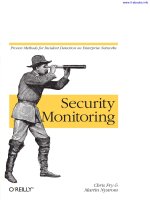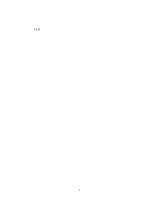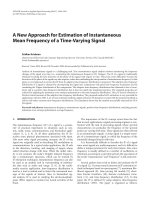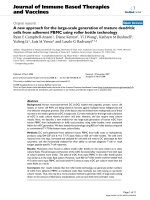New approach for malware detection on workstations
Bạn đang xem bản rút gọn của tài liệu. Xem và tải ngay bản đầy đủ của tài liệu tại đây (692.89 KB, 10 trang )
Nghiên cứu khoa học công nghệ chưa rõ không xóa
New approach for malware detection on Endpoint system
Nguyen Duc Viet 1*
PTIT,
ABSTRACT
The attack technique by the malware distribution form is a dangerous, difficult to detect and prevent
attack method. Current malware detection studies and proposals are often based on two main methods:
using sign sets and analyzing abnormal behaviors using machine learning or deep learning techniques.
This paper will propose a method to detect malware on Endpoints based on Event IDs using deep learning.
Event IDs are behaviors of malware tracked and collected on Endpoints' operating system kernel. The
malware detection proposal based on Event IDs is a new research approach that has not been studied and
proposed much. To achieve this purpose, this paper proposes to combine different data mining methods
and deep learning algorithms. The data mining process is presented in detail in section 2 of the paper.
Keywords - Malware detection; Event analysis technique; deep learning; Doc2Vec
1.
INTRODUCTION
Two currently commonly used methods for malware detection include the sign-based detection method
and the abnormal behavior-based detection method [1, 2, 3, 4, 5]. Detection methods based on anomalous
behavior have been highly effective due to their ability to detect new malware types. Behavior-based
detection approaches often seek ways to extract anomalous behaviors of malware and then use methods
and algorithms to classify malware. However, it can be seen that the common characteristic of these
methods is the use of methods to extract signs and behaviors of malware based on sample datasets. These
datasets are built based on virtualization tools or static analysis and network monitoring tools. Regarding
virtualization tools, studies often use the Sandbox tool [6] to execute and extract malicious's behaviors.
The disadvantage of Sandbox tools is only recording behaviors in a certain time, so it will not be possible
to fully statistics malware's behavior. Regarding datasets collected during the static analysis process, using
them only detects anomalies when malware has spread and connected to steal data. Therefore, these
traditional approaches are always bypassed by malware. To solve these problems, this paper proposes a
new approach based on analyzing abnormal behaviors of Event IDs. The characteristic of our approach is
that instead of using virtualization tools to collect and extract malware's abnormal behaviors, this
approach relies on Event IDs generated by the malware as a basis for detecting abnormal signs and
behaviors of malware. These Event IDs are then analyzed by using different data mining methods to seek
and aggregate malware's abnormal behaviors. Next, the Seq2Vec algorithm is proposed to be used to
synthesize and normalize features of Event IDs. Finally, to conclude about the existence of malware in the
system, we use deep learning algorithms such as Multilayer Perceptron (MLP), Convolutional Neural
Network (CNN), Long short term memory (LSTM). The novelty and scientific quality of our research are
as follows:
Proposing a malware detection method based on Event IDs. This is a new approach for detecting
malware on Endpoints. This approach has not been published yet by any publications.
Proposing a method to analyze malware's abnormal behaviors based on Event IDs using the Seq2Vec
technique. Although the use of the Seq2Vec model to normalize text data is a common problem, when
applying this model to normalizing malware data, it is a new problem and has not been studied and
applied by many works. Especially, the application of this model to the process of normalizing Event IDs
has not been proposed by any research.
2.
RELATED WORKS
Tạp chí Nghiên cứu KH&CN quân sự, Số 32, 08 - 2014
chưa rõ khơng xóa
1
Chưa rõ khơng xóa Vật lý kỹ thuật
Studies [1, 2, 3] presented some malware detection methods. In the research [7], Zhong et al. proposed
a method of using multiple deep-learning layers for malware detection. Specifically, in their proposed
model, the authors proposed a detection method based on 5 phases: Phase 1: Choosing prominent static
and dynamic features; Phase 2: Using the parallel improved K-means algorithm to partition the dataset
into multiple one-level clusters; Phase 3: Generating multiple sub-clusters in parallel; Phase 4: Building
the deep learning model for each sub-cluster in parallel; Phase 5: Classifying samples as malware or
benign based on decision values of deep learning models. In the study [8], Fei Xiao et al. proposed a
malware detection method using the Stacked AutoEncoders (SAEs) deep learning network. In the
experimental section, the authors compared and evaluated the SAEs model with other machine learning
and deep learning algorithms. Experimental results showed that the SAEs model brought better results
than other models. Studies [9, 10] proposed a method to detect malware based on some machine learning
algorithms such as Decision Tree (DT), K-Nearest Neighbor (KNN), Naïve Bayes (NB), and Support
Vector Machine (SVM). In studies [11, 12] the authors proposed some malware detection methods based
on Window API calls using machine learning and deep learning algorithms. In addition, the report [13]
listed some technology solutions for detecting malware on Endpoints (Endpoint Detection & Response)
based on rule sets and behaviors. Accordingly, technology solutions include Trend Micro EDR Apex One,
Palo Alto Networks Traps, WildFire, Kaspersky EDR, Carbon Black EDR, and Falcon.
3. PROBLEM
3.1.
The proposed model architecture
3.3.1. The proposed model architecture
Endpoint
Collect process
on kernel
Extract behaviors
of Event ID
Extract malware
features using
Sequence
Event ID
Embedding vector
Malware
Classify
behavior profiles
Normal
Figure 1
The architecture of the proposed APT malware detection model
From Figure 1, seeing the operation process of the system as follows:
- Step 1: Collect and process Event IDs on Endpoints. To perform the task of collecting and
extracting these processes, we install and configure the main tool, Sysmon [14]. These tools have
the function of collecting the processes recorded by the operating system and transferring these
processes to the processing and monitoring center. The processes in Sysmon are described in
detail in Table I of Section 2.2.
- Step 2: Extract abnormal behaviors of Event IDs. At this step, abnormal features and behaviors
are extracted from the Event IDs collected from the client-side. These features and behaviors are
the basis for malware detection. Details of abnormal behaviors of Event IDs are presented in
Section 2.3.
- Step 3: Extract abnormal behaviors of malware. As is known, in step 2, the research has
extracted anomalous behaviors in Event IDs. Here each file has different characteristics and
different number of Event IDs. Therefore, need a method to normalize and process these files. To
accomplish this task, we propose to use the Seq2Vec model. Accordingly, each Event ID is
considered as a “word” and a file is a collection of words. Finally, the file consisting of words is
normalized to a homogenous vector using the Seq2Vec model. Details of this process are
described in Section 2.4.
2
T. H. Trung, “Tối ưu bức xạ trong môi trường nhiều người… WCDMA/HSDPA.”
Nghiên cứu khoa học công nghệ chưa rõ không xóa
-
Step 4: Detect malware. At this step, the malware's behaviors, which are normalized and built in
step 3, are classified by a deep learning algorithm to conclude about malware in the system. This
process is presented in detail in section 2.5 of the paper
3.3.2. The method to extract processes of malware
In this paper, to collect malware's behaviors on the operating system kernel, we propose to use the
Sysmon tool [14]. The Sysmon tool is one of the powerful tools developed by Microsoft to support the
task of collecting and analyzing anomalous behavior on Endpoints using the Windows operating system.
Accordingly, the main 22 behaviors collected by the Sysmon tool on the Endpoints' operating system
kernel are presented in the report [14] including Process creation, Network connection, Sysmon service
state changed, Process terminated, Driver loaded, CreateRemoteThread, etc
3.3.3. The method to extract abnormal features of malware based on the processes
Thus, based on 22 Event IDs collected in the operating system kernel by the Sysmon tool, this paper
will analyze these Event IDs to collect anomalous behaviors in each Event ID. Table 1 below lists
abnormal behaviors found in Event IDs. These behaviors are the new anomalous behaviors proposed by
ours
Table 1 List of abnormal behaviors collected on the operating system kernel
No.
Type
Feature name
Description
1
KEYSTROK
ES Loggers
GetAsyncKeyState
Poll the state of each keys on the keyboard using the
function.
2
GetKeyState
Retrieves the status of the specified virtual key
3
SetWindowsHook
Installs an application-defined hook procedure into a
hook chain
WSASocket
Create a raw socket
socket
Create a raw socket
6
bind
Bind socket to an interface
7
WSAIoctl
Put interface (NIC) in to Promiscuous mode
8
ioctlsocket
Put interface (NIC) in to Promiscuous mode
4
5
Network
traffic monitor
9
Downloader
URLDownloadToFile
Download file and save to disk
10
Execution
WinExec
Execute file
11
LoadModule
Loads and executes an application or creates a new
instance of an existing application.
12
LoadPackagedLibrary
Loads the specified packaged module
13
CreateProcess
Create new process
14
ShellExecute
Execute file
InternetOpen
Initializes an application's use of the WinINet
functions
16
InternetConnect
Url Input
17
HttpOpenRequest
Build HTTP request
18
HttpAddRequestHeaders
Build HTTP request
19
HTTPSendRequest
Send HTTP Request
20
InternetReadFile
Read Response
FindResource
Find Resource
15
21
HTTP CNC
Traffic
Droppers
Tạp chí Nghiên cứu KH&CN quân sự, Số 32, 08 - 2014
chưa rõ khơng xóa
3
Chưa rõ khơng xóa Vật lý kỹ thuật
22
LoadResource
Retrieves a handle that can be used to obtain a pointer
to the first byte of the specified resource in memory.
23
SizeOfResource
Retrieves the size of resource
24
LockResource
Retrieves a pointer to the specified resource in
memory.
SetWindowsHook
Install the filter function in the hook chain of the
remote processWorks only for GUI application
26
LoadLibrary
Load the malicious DLL into attacking process’s
address space.
27
GetProcAddress
Retrieve the address of the filter function on the
remote process.
28
GetWindowsThread
ProcessId
Get ID of Target thread.
29
BroadcastSystemMessage
This is used to send message by attacking process to
victim process (internally).
30
VirtualAlloc
Standard windows api call that allows one process to
allocate memory space inside another process
31
WriteProcessMemory
Writes data to an area of memory in a specified
process
32
GetModuleHandle
Allows the process to determine how to access some
dll that might be loaded into the memory space
33
GetProcAddress
Retrieves the address of an exported function or
variable from the specified dynamic-link library
34
CreateRemoteThread
Create a remote thread inside a remote process
GetProcAddress
Locate address of a function to hook
36
VirtualProtect
Set memory protection to read/write
37
ReadProcessMemory
Save first few bytes of victim
38
VirtualProtect
Restore memory permission to original value
CreateProcess
Create a process in suspended state.
NtUnmapViewOfSection
Unmap contents of the original process from memory
41
VirtualAlloc
Allocate new memory address in to the hollow
process
42
WriteProcessMemory
Brand new code is injected to the hollow process
ResumeThread -> Resume the process
GetTickCount
Identify the time to detect a debugger is present
CountClipboardFormats
API call to determine whether victim’s clipboard was
empty
45
GetForeGroundWindow
API call to check if the color of the foreground
window was changing,assuming automated sandbox
tools doesn’t switch active windows around
46
Isdebuggerpresent
Detect debugger
25
35
39
40
43
44
Hooking
Process
hollowing
AntiDebugger
/VM detection
47
ShellCode
GetEIP
Methods SHELLCODE often uses to determine where
in memory it is loaded.
48
File and
Directory
CreateFile
Creates or opens a file or I/O device
OpenFile
Open a file
FindFirstFile
Searches a directory for a file or subdirectory with a
49
50
4
DLL Injection
T. H. Trung, “Tối ưu bức xạ trong môi trường nhiều người… WCDMA/HSDPA.”
Nghiên cứu khoa học công nghệ chưa rõ không xóa
name that matches a specific name
51
FindNextFile
Continues a file search
52
GetWindowsDirectory
Retrieves the path of the Windows directory.
53
remove
Deletes the file specified by path
54
GetTempPath
Returns the path of the current user's temporary folder
55
DeleteFile
Deletes the file specified by path
RegOpenKey
Opens the specified registry key
57
RegCreateKey
Creates the specified registry key
58
RegSetValue
Sets the data for the default or unnamed value of a
specified registry key
System
executes an internal operating system command
WinExec
Runs the specified application
CreateService
Creates a service object and adds it to the specified
service control manager database.
62
ControlService
Sends a control code to a service
63
StartServiceCtrlDispatcher
Connects the main thread of a service process to the
service control manager
CreateProcess
Create new process
65
GetProcessId
Retrieves the process identifier of the specified
process
66
Process32First
Retrieves information about the first process
encountered in a system snapshot
67
Process32Next
Retrieves information about the next process recorded
in a system snapshot
68
OpenProcess
Opens an existing local process object
56
59
Registry Keys
PowerShell
60
61
64
Service
Process
3.3.4. The method to build malware behavior using sequence
As is known, each malware has the different number of Event IDs, so it is a difficult task to uniform
the length of each file. In this paper, each executable file is considered as a document and each Event as a
"word" in the document. The next task is how to normalize a document into a uniform vector. To perform
this task, this study proposes to use the Seq2Vec model. The Seq2Vec method was proposed by
Dhananjay et al. in 2016 [15]. The characteristic of this method is to vectorize files by using the Doc2Vec
algorithm. In which, Doc2Vec, which was introduced by Quoc Le and Mikolov [16], includes 2 main
models: Distributed Memory Model of Paragraph Vectors (PV-DM) and Distributed Bag of Words
version of Paragraph Vector (PV-DBOW). In this paper, we use the PV-DBOW model. This is a similar
model as the Skip-gram model for word2vec. The difference is that the input of Skip-gram is a word,
while the input of PV-DBOW is a document ID (in this study, it is an executable file ID). In this model,
only softmax weights need to be stored instead of both softmax weights and word vectors as PV-DM
model. As a result, the Doc2Vec model represents processes into corresponding vectors. Figure 2 below
illustrates how to vectorize an executable file using the PV-DBOW model.
Tạp chí Nghiên cứu KH&CN quân sự, Số 32, 08 - 2014
chưa rõ khơng xóa
5
Chưa rõ khơng xóa Vật lý kỹ thuật
Input
Layer
Hidden Layer
Output Layer
Event i
Event i+1
Execu
table File
ID
Event i+2
Event i+3
Figure 2 How the PV-DBOW model works for vectorizing an executable file
The process of applying the Seq2Vec model to the task of standardizing malware data has the following steps:
-
Step 1: Sorting the processes in the order of appearance. Representing a file as a sequence: a file
has many processes, consider a file as a record and a process as a word.
Step 2: Vectorizing the file by using the Doc2vec algorithm using the Skip-gram model. This
paper configures the Seq2Vec model with output parameters of 64, 128, and 256 features,
respectively.
3.3.5. Classification method
After malware's processes are collected, and features are extracted and normalized, we obtain a unique
vector representing features of the malware. Next, based on this feature vector, this study evaluates to
conclude which are normal files and which are malicious files. This paper uses some deep learning and
machine learning algorithms to classify files as normal or malware. Specifically, we propose to use some
deep learning algorithms and models: Multilayer Perceptron (MLP), Convolutional Neural Network
(CNN), Long short term memory (LSTM), Random forest (RF). Regarding the MLP network, the study
[17] presented the MLP network architecture in detail. It is built by simulating how neurons work in the
human brain. MLP networks usually have 3 or more layers: 1 input layer, 1 output layer, and more than 1
hidden layer. Besides, the efficiency of the MLP network depends on the activation function. This paper
will tune-fine the activation function parameter to evaluate the effectiveness and suitability of activation
functions for the malware detection task. The CNN network is a basic layer set consisting of convolution
layer + nonlinear layer, fully connected layer. The structure and the terms (stride, padding, MaxPooling)
of CNN were presented in detail in the research [18]. In this paper, choose to use the ReLU activation
function for CNN. Regarding the LSTM network, it was introduced in the study [19] with the ability to
remember information for a long time. This is expressed in the structure of the ports in each memory cell.
A memory cell consists of three main components: input gate, forget gate, and output gate. Firstly, the
forget gate decides what information should be discarded in the cell state. Next, the input gate decides
what information is updated into the cell state. Finally, the output gate calculates the desired output.
During this process, the cell state is propagated through and updated as it passes through all nodes.
3.2.
Experiments and evaluation
3.2.1. Experimental dataset
In this paper, we use normal and malware data from the source [20]. Specifically, we collected 52,135
malware files including Agentesla, Azorult, Emotet, Formbook, Gandcrab, Hawkeye, Lokibot, Njrat,
Pony, Qbot, Quasar, Remcos, Trickbot, Ursnif, Vidar, etc. Regarding normal data, the research seeks ways
to collect files including PE EXE, PE DLLs, JAVA HTML, Documents, Adobe Flash, Microsoft Office,
etc. The total number of malware files is 25,437.
3.2.2. Experimental scenario
This study divides the experimental dataset into different components and then conducts experiments
and evaluates the accuracy of the proposed models based on these experimental sub-datasets. The whole
process of dividing the experimental dataset for the scenarios is chosen at random in which 80% of the
6
T. H. Trung, “Tối ưu bức xạ trong môi trường nhiều người… WCDMA/HSDPA.”
Nghiên cứu khoa học công nghệ chưa rõ không xóa
dataset is used for training, the remaining 20% is used for testing. To evaluate the effectiveness of the
proposal in the study, we conduct 2 evaluation scenarios as follows:
- Scenario 1: Compare and evaluate the effectiveness of deep learning methods. For this scenario, we
conduct the evaluation with the following algorithms: MLP, CNN, LSTM. During the experiment, we
tune-fine the parameters to see the effectiveness of the deep learning models. Thus, in this
scenario, the paper evaluates 3 models including Seq2Vec-MLP, Seq2Vec-CNN, and Seq2VLSTM.
- Scenario 2: Compare and evaluate the deep learning models with some other approaches on the same
dataset.
3.2.3. Classification measures
This paper uses 4 following measures to evaluate the accuracy of models:
1. Accuracy: The ratio between the number of samples classified correctly and total number of
samples.
2. Precision: The ratio between the true positive value and total number of samples classified as
positive. The higher value of precision, the more accurate in malicious sample detection.
3. Recall: The ratio between the true positive value and the total real malicious samples. The higher
value of recall, the lower rate of missing positive samples.
F1-score: The harmonic mean of precision and recall
3.2.4. Experimental results
3.2.4.1. Experimental results of scenario 1
Our purpose in scenario 1 is to compare and evaluate the classification ability of the deep learning
model in the malware detection problem based on the different measures presented in the previous subsection. The experimental results of scenario 1 are presented in tables 2, 3, 4 below
Table 2. Experimental results using Seq2Vec-MLP model
Parameter
Evaluation
Features
Layers
Acc
Pre
Rec
F1
Train time
Test time
64 features
2
96.86
94.47
89.15
91.43
1144.02
2.69
4
96.9
94.65
89.14
91.82
1282.52
2.65
2
96.88
93.87
89.89
90.11
1222.44
2.24
4
97.07
95.2
89.53
92.28
1282.52
2.65
2
96.96
94.86
89.27
91.98
1185.45
2.21
4
96.05
94.53
89.06
92.18
1282.63
2.68
128 features
256 features
Table 3. Experimental results using Seq2Vec-CNN model
Parameter
Features
64 features
128 features
256 features
Layers
Evaluation
Acc
Pre
Rec
F1
Train time
Test time
96
96.64
92.34
90.3
91.3
1552.34
2.89
32-64
96.86
94.85
88.73
91.69
1762.69
3.2
512
96.88
93.96
89.81
91.84
2895.74
5.22
128-256
96.88
93.84
89.94
91.85
2482.65
5.25
512
96.87
93.23
90.52
91.85
2962.68
5.23
64-128
96.89
94.03
89.77
91.85
2242.75
3.59
Tạp chí Nghiên cứu KH&CN qn sự, Số 32, 08 - 2014
chưa rõ khơng xóa
7
Chưa rõ khơng xóa Vật lý kỹ thuật
Table 4. Experimental results using Seq2Vec-LSTM model
Parameter
Evaluation
Features
Layers
Acc
Pre
Rec
F1
Train time
Test time
64
features
512-512128
96.73
93.97
88.98
91.41
1105
8.2
256-256512-128
96.78
94.13
89
91.53
1119
9.4
128-512256
96.88
94.6
89.14
91.8
925.43
8.64
256-512256-128
96.85
94.26
89.3
91.71
1141
9.6
128-172256
96.93
94.43
89.57
91.94
1309.8
10.5
172-512256-512
96.86
94.57
89
91.74
1826.8
12.67
128
features
256
features
Based on the experimental results in Table 2, the Seq2Vec-MLP model gave different efficiency when
changing the parameters of this model. However, this change is not too large because the difference
between models is only about 0.1%. Regarding the time variation between models, obviously, when
increased the number of hidden layers of the MLP model and the number of features of the Seq2Vec
model, the training time increased markedly. Regarding the accuracy of the Seq2Vec-MLP model, the
model gave the highest results at the parameter {Seq2Vec: 256 features, MLP: 2 layers}.
From the results in Table 3, seeing that the Seq2Vec-CNN model has many similarities with the
Seq2Vec-MLP model. Specifically, in terms of training and testing time, when increased the number of
layers and features in the model, the training and testing time increased greatly. Besides, regarding the
efficiency of the detection process, the models also gave different results when changing the parameters.
However, this change is irregular. When the complexity increased, the accuracy did not always increase.
Seq2Vec-CNN model had the best results with Accuracy, Precision, Recall, F1-score measures of 96.89%,
94.03%, 89.77%, and 91.85%, respectively.
The experimental results in Table 4 show that the Seq2V-LSTM model worked relatively effectively
for both tasks of classifying malware and normal file. The best Accuracy detection result is 96.93%. This
result is about 0.2% higher than the lowest result. Regarding correctly classifying normal files, this model
gave the best results as 94.57% when using 256 features and 4 LSTM layers. In addition, regarding
correctly classifying malware, with an efficiency of 89.57%, the Seq2V-LSTM model has shown
superiority compared to other models using CNN or MLP. In terms of detection time, obviously, the more
complex the model with many LSTM layers and the extension of the feature vector, the more processing
time is required for the Seq2V-LSTM model.
3.2.4.2. Experimental results of scenario 2
Our purpose in this scenario is to experiment with some other models and approaches in the malware
detection task. Accordingly, in addition to the Seq2Vec-CNN model proposed in the study [21] (the
experimental results of this model showed in Table 3), we conduct experiments with the Seq2Vec-RF
model [22]. This model was proposed in the study [22]. Table 5 below describes the experimental results
of this model.
The experimental results in Table 5 show that the Seq2Vec-RF model worked best (with Accuracy,
Precision, Recall, and F1-score measures of 96.81%, 94.13%, 89.16%, and 91.58%, respectively) when
the RF algorithm uses 100 decision trees and Seq2Vec uses 256 features.
8
T. H. Trung, “Tối ưu bức xạ trong môi trường nhiều người… WCDMA/HSDPA.”
Nghiên cứu khoa học công nghệ chưa rõ không xóa
Table 5. Experimental results using Seq2Vec-RF [22]
Parameter
Evaluation
Features
Trees
Acc
Pre
Rec
F1
Train time
Test time
64 features
10
96.01
94.01
85.03
89.3
65.97
0.22
50
96.57
93.97
88.2
91
342.16
01.03
100
96.61
93.91
88.17
90.95
680.71
2.1
10
96.32
94.23
86.45
90.17
93.46
0.27
50
96.79
94.61
88.49
91.45
473.74
1.36
100
96.74
94.33
88.63
91.39
946.85
2.58
10
96.41
94.15
86.93
90.4
140.71
0.39
50
96.87
94.41
89.15
91.7
686.3
1.71
100
96.81
94.13
89.16
91.58
1393.67
3.36
128 features
256 features
3.2.4.3. Discussion
Table 6 below summarizes the results of the process of implementing the two comparison scenarios
that we have evaluated
Table 6. Comparison table of malware detection results of some models
Evaluation
Model
Acc
Pre
Rec
F1
Train time
Test time
Seq2Vec-RF [22]
96.81
94.13
89.16
91.58
1393.67
3.36
Seq2Vec- CNN [21]
96.89
94.03
89.77
91.85
2242.75
3.59
Seq2V-LSTM [our proposal]
96.93
94.43
89.57
91.94
1309.8
10.5
Comparing the results in Table 6, seeing that our proposed Seq2V-LSTM model brought better results
than the models proposed in other studies. However, this difference is not too significant. This shows that
the Seq2V-LSTM model has worked effectively in the task of extracting features and classifying
malware's abnormal behaviors compared to other studies. In terms of training and testing time, the
Seq2Vec-LSTM model took more time than all other models.
4.
CONCLUSION
Detecting malware on Endpoints is a difficult and challenging task. This paper proposed an approach
for detecting malware on Endpoints based on abnormal behaviors of Event IDs using deep learning. Our
new proposal in this study has shown superiority when it gave better performance than other methods on
the same experimental dataset. This shows that the approach of detecting malware based on Event IDs on
the operating system kernel is reasonable and correct. Besides, the proposal of using the Seq2Vec model
for the task of synthesizing and extracting malware's features based on Event IDs has brought high
efficiency. This model has successfully standardized malware's behaviors to help the malware
identification system to be more efficient. In the future, in order to improve the efficiency of the malware
detection process on Endpoints, the authors propose 2 improved methods: i) find ways to build
relationships between Event IDs, ii) propose new embedding methods to standardize malware's features
Tạp chí Nghiên cứu KH&CN quân sự, Số 32, 08 - 2014
chưa rõ không xóa
9
Chưa rõ khơng xóa Vật lý kỹ thuật
REFERENCES
[1]
Yanfang Ye, Tao Li, Donald Adjeroh, S. Sitharama Iyengar, A survey on malware detection using data mining techniques, ACM Comput.
Surv, 50, 2017. />
[2]
Daniel Gibert, Carles Mateu, Jordi Planes, The rise of machine learning for detection and classification of malware: Research
developments, trends and challenges, Journal of Network and Computer Applications, 153, pp. 1-22, 2020.
[3]
Ucci, Daniele & Aniello, Leonardo, Survey on the Usage of Machine Learning Techniques for Malware Analysis, Computers & Security,
81, 2017. />
[4]
Sanjay Sharma, C. Rama Krishna, Sanjay K. Sahay, Detection of Advanced Malware by Machine Learning Techniques, 2019.
arXiv:1903.02966.
[5]
Alireza Souri, Rahil Hosseini, A state‑of‑the‑art survey of malware detection approaches using data mining techniques, 8, no. 3, pp 1-22,
2018. />
[6]
Important Information Regarding Sandboxie Versions. (Accessed on 26 August 2020)
[7]
Zhong Wei, Gu Feng, A Multi-Level Deep Learning System for Malware Detection, Expert Systems with Applications, 133, 2019.
/>
[8]
Fei Xiao, Zhaowen Lin, Yi Sun, Yan Ma, Malware Detection Based on Deep Learning of Behavior Graphs, Mathematical Problems in
Engineering. />
[9]
M. Fan, J. Liu, X. Luo et al., Android malware familial classification and representative sample selection via frequent subgraph analysis,
IEEE Transactions on Information Forensics and Security, 13, no. 8, pp. 1890–1905, 2018.
[10] Z. Lin, X. Fei, S. Yi, Y. Ma, C.-C. Xing, J. Huang, A secure encryption-based malware detection system, KSII Transactions on Internet and
Information Systems, 12, no. 4, pp. 1799–1818, 2018.
[11] B. Kolosnjaji, A. Zarras, G. Webster, and C. Eckert, Deep learning for classification of malware system call sequences, in proceedings of
the Australasian Joint Conference on Artificial Intelligence, Lecture Notes in Comput. Sci., pp. 137–149, 2016.
[12] B. S. Abhishek and B. A. Prakash, Graphs for malware detection: the next frontier, in proceedings of the 13th International Workshop on
Mining and Learning with Graphs (MLG), 2017.
[13] Endpoint Detection and Response Solutions Market- />(Accessed on 26 August 2020).
[14] Sysmon v10.42. (Accessed on 26 August 2021).
[15] Dhananjay Kimothi, Akshay Soni, Pravesh Biyani, James M. Hogan, Distributed Representations for Biological Sequence Analysis.
arXiv:1608.05949v2.
[16] Quoc V. Le, Tomas Mikolov, Distributed Representations of Sentences and Documents. arXiv:1405.4053.
[17] Daniel Svozil, Vladimir Kvasnicka, Jiří Pospíchal, Introduction to multi-layer feed-forward neural networks, Chemometrics and Intelligent
Laboratory Systems, 39, no. 1, pp. 43-62, 1997
[18] Keiron O’Shea, Ryan Nash, An Introduction to Convolutional Neural Networks. arXiv, arXiv:1511.08458.
[19] Sepp Hochreiter, Jürgen Schmidhuber, Long Short-Term Memory, Neural Computation, 9, no. 8, pp. 1735 - 1780, 1997.
[20] Malware hunting with live access to the heart of an incident. (Accessed on 26 August 2021).
[21] S. Tobiyama, Y. Yamaguchi, H. Shimada, T. Ikuse, T. Yagi, Malware Detection with Deep Neural Network Using Process Behavior, in
proceedings of 2016 IEEE 40th Annual Computer Software and Applications Conference (COMPSAC), pp. 577-582, 2016.
/>[22] Mehadi Hassen, Mehadi Hassen, Scalable Function Call Graph-based Malware Classification, in proceedings of the Seventh ACM on
Conference on Data and Application Security and Privacy, pp. 239–248, 2017. />
TÓM TẮT
Đề xuất phương pháp tiếp cận mới cho phát hiện mã độc trên máy trạm dựa
trên kỹ thuật phân tích Event
Kỹ thuật tấn cơng bằng hình thức phát tán mã độc là cách thức tấn công nguy hiểm, khó
phát hiện và phịng tránh. Các nghiên cứu và đề xuất về phát hiện mã độc hiện nay
thường dựa trên 2 phương pháp chính là sử dụng tập dấu hiệu và phân tích hành vi bất
thường dựa trên kỹ thuật học máy hoặc học sâu. Trong bài báo này, chúng tôi sẽ đề xuất
phương pháp phát hiện mã độc trên máy người dựa trên Event ID sử dụng học sâu.
Event ID những hành vi của mã độc được theo dõi, thu thập trên nhân hệ điều hành của
máy trạm. Đề xuất phát hiện mã độc dựa trên Event ID là nghiên cứu mới chưa có nhiều
nghiên cứu và đề xuất. Để thực hiện được mục tiêu này bài báo đã đề xuất kết hợp các
phương pháp khai phá dữ liệu khác nhau và thuật toán học sâu.
Từ khoá: Phát hiện phần mềm độc hại; Kỹ thuật phân tích sự kiện; học kĩ càng; Doc2Vec
10
T. H. Trung, “Tối ưu bức xạ trong môi trường nhiều người… WCDMA/HSDPA.”









